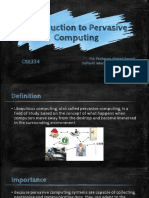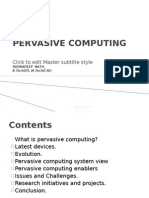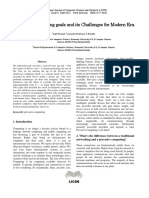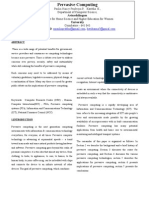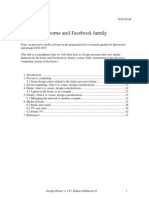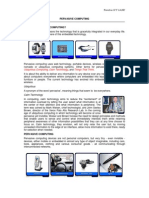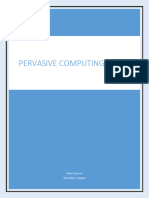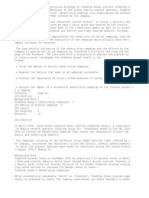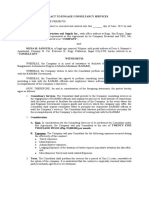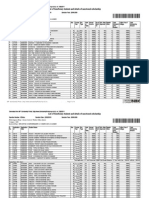Pervasive Computing
• In the 19th Century, James Watt changed the world.
– The steam engine – extended the power and strength of
workers.
– Centralised energy
• Other inventions changed this centralised view of
energy
– Von Siemens dynamo in 1866
– Edison – power plant in 1882
– Diesel – engine in 1892
Mar 10, 2010 Pervasive Computing 1
Pervasive Computing
• Energy became decentralised.
– Could provide energy anywhere at anytime.
• The ubiquituous availability of energy
changed lifestyles.
– Mass production, reduced costs, raised wages.
– More applications spread to homes – fridges,
tv, lawn mowers
Mar 10, 2010 Pervasive Computing 2
Pervasive Computing
• Applications are distinguished by
– Convenience
– Usability for a specific purpose
– Hiding the technology
• The applications changed the world, NOT
the technology by itself.
Mar 10, 2010 Pervasive Computing 3
Pervasive Computing
• In the 20th century – computers arrived.
– Mental capabilities are multiplied.
– Process larger amounts of information, bills, payrolls,
invoices and other data.
• Computers began as room filling and mysterious
black boxes.
– Centralised, tightly controlled systems
– Closed shop IT concentrated on a static environment
for users.
Mar 10, 2010 Pervasive Computing 4
Pervasive Computing
• Similar to the Industrial Revolution
– Move from centralised to a more pervasive or
decentralised computing environment.
– The PC has conquered
– Computing is intrinsic to
• Entertainment, commerce, telecommunication,
finance, industry
• We have a high tech culture relying on electronic
creation, storage and transmission of personal and
business information.
Mar 10, 2010 Pervasive Computing 5
Pervasive Computing
• E-Business
– Perform business processes on computer
systems.
– Efficiency, productivity, vitality
– Allows for a more dynamic reaction to markets
– Changes the way of dealing with customers and
partners
Mar 10, 2010 Pervasive Computing 6
Pervasive Computing
• The Internet
– No longer the world wide wait
– A standard communication platform
– Global village
– Small firms can take advantage of new
technology to great advantage.
Mar 10, 2010 Pervasive Computing 7
Pervasive Computing
• Decentralisation
– Facing an omnipresence of computing.
– Beyond Personal Computing is Pervasive
Computing
• New class of device makes information access and
processing easily available anywhere, anytime.
Mar 10, 2010 Pervasive Computing 8
Pervasive Computing
• Lightweight PC
– Handheld computers – a complementary
interface to intelligent networks
• Smart cards – secure and very small
• Mobile phones
• Set top boxes, interactive tv, game consoles
– interface between entertainment systems
and entertainment providers.
Mar 10, 2010 Pervasive Computing 9
Pervasive Computing
• Intelligent Appliances – access to a variety
of controls from a remote internet browser.
• Industrial Controllers
• Embedded Systems – cruise control, on-
board phones, GPS, security features,
biometric data.
Mar 10, 2010 Pervasive Computing 10
Pervasive Computing
• Applied Pervasive
– Technical issues
• Limitations on memory use
• Processor performance
• Power consumption
• Footprint of OS and applications
• Power shortages – what happens when?
• Multiple platforms (hardware and software)
Mar 10, 2010 Pervasive Computing 11
Pervasive Computing
• Technology advances…. quickly.
• Devices get smaller, capacity increases
– Embedded processor of a smart card already has the
same power as the first PC.
• Wireless networks
• Bandwidth
• Endless demand for exchanging and sharing
information.
Mar 10, 2010 Pervasive Computing 12
Pervasive Computing
• With new technical possibilities comes new kinds
of application and services.
• Telecoms companies missed the Internet
movement
– ISPs like AOL grew to compete with them.
– Now getting in on the next computing generation
• Promoting high bandwidth networks, wireless
Mar 10, 2010 Pervasive Computing 13
Pervasive Computing
– Telecoms and IT are merging silently.
• New appliances and applications will increase the
demand for networking technology and capacity.
• Email, wireless, high bandwidth, paging, SMS,
internet access
• Value-add services beyond voice
Mar 10, 2010 Pervasive Computing 14
Pervasive Computing
– Commerce and Retail
• New chances of being successful in existing markets
and reaching new ones.
• Mobile Commerce succeeds eCommerce
– Connecting existing services to mobile devices to improve
customer satisfaction and convenience.
– Leads to new demand because of enhanced shopping
experience.
Mar 10, 2010 Pervasive Computing 15
Pervasive Computing
• Entertainment
– Broad field of applications and services
• Video-on-demand
• Interactive television
• With new technology, traditional broadcasters face
new competition, growth and profits.
Mar 10, 2010 Pervasive Computing 16
Pervasive Computing
• Industry will adopt Pervasive Computing to
increase productivity.
– Pervasive devices will appear in manufacturing,
logistics, management and sales enabling
ubiquituous access to enterprise data.
– Flexible responses need well informed
employees.
Mar 10, 2010 Pervasive Computing 17
Pervasive Computing
• Computers will be more and more invisible.
– Motor in the tray of a CD player is taken for granted.
– Similarly, a computer system in an mp3 player will be
taken for granted.
• Expected to download titles, provide information etc.
• We won’t care if it is Java inside, how the TCP/IP stack is
implemented.
• The application and service is what is important.
Mar 10, 2010 Pervasive Computing 18
Pervasive Computing
• Principles of Pervasive Computing
– Decentralisation
– Diversification
– Connectivity
– Simplicity
Mar 10, 2010 Pervasive Computing 19
Decentralisation
• Mainframe Era
– Powerful centralised computing
– Dumb terminals
• Move to Client-Server
• Pervasive Computing
– Distributes responsibility between a variety of small
devices (specific tasks)
– Each contributes to a heterogeneous overall computing
landscape.
Mar 10, 2010 Pervasive Computing 20

